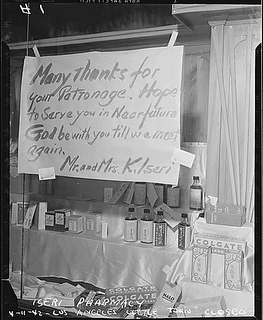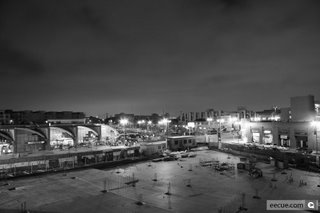






On KPCC this morning, there was an all-to-brief summary of the history of Little Tokyo, which is celebrating the 66th Nisei Week. Not the 66th annual Nisei week, mind you, for as they neglected to include in their broadcast, the Japanese-American community was summarily uprooted during World War II, and incarcerated. During those years, Little Tokyo reverted to Bronzeville, as African-Americans seeking work in the rapidly expanding defense industry across Southern California returned to the area.
In the period from approximately 1880 to 1910, what is now known of as Little Tokyo had been the center of the African-American community in Los Angeles, centered around East First Street and Wolfskill, later renamed Central Avenue. As whites urbanized and developed farmland to the south, the African-American community slowly followed in their wake. Due to restrictive covenants, the African-American community by and large could only live within the tracts adjacent to Central Avenue, thus giving birth in the decades to follow to what became known as "South Central."
In the segregated era of the day, the only portion of Los Angeles where newly arrived Japanese immigrants were allowed to live was within the colored community. The Japanese-American presence mushroomed after the 1906 earthquake in San Francisco. As the center of the African-American community moved south, Little Tokyo emerged.
There is a link above to the official Nisei Week site, but beware: the site is as unnavigable as it is lacking in detail concerning the exact times and locations of dozens of events taking place around an area comprising more than 20 city blocks.
In the period from approximately 1880 to 1910, what is now known of as Little Tokyo had been the center of the African-American community in Los Angeles, centered around East First Street and Wolfskill, later renamed Central Avenue. As whites urbanized and developed farmland to the south, the African-American community slowly followed in their wake. Due to restrictive covenants, the African-American community by and large could only live within the tracts adjacent to Central Avenue, thus giving birth in the decades to follow to what became known as "South Central."
In the segregated era of the day, the only portion of Los Angeles where newly arrived Japanese immigrants were allowed to live was within the colored community. The Japanese-American presence mushroomed after the 1906 earthquake in San Francisco. As the center of the African-American community moved south, Little Tokyo emerged.
There is a link above to the official Nisei Week site, but beware: the site is as unnavigable as it is lacking in detail concerning the exact times and locations of dozens of events taking place around an area comprising more than 20 city blocks.
No comments:
Post a Comment